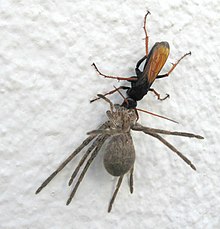
Wasps in the family Pompilidae are commonly called spider wasps, spider-hunting wasps, or pompilid wasps. The family is cosmopolitan, with some 5,000 species in six subfamilies. Nearly all species are solitary, and most capture and paralyze prey, though members of the subfamily Ceropalinae are kleptoparasites of other pompilids, or ectoparasitoids of living spiders.

Pepsis is a genus of spider wasps belonging to the family Pompilidae. Species within this genus are also called tarantula hawks, as they usually hunt tarantulas, similarly to many species in the genus Hemipepsis. These wasps are restricted to the Americas, with the related genus Hemipepsis occurring in both Old and New Worlds.

The Pompilinae are a subfamily of the spider wasp family, Pompilidae, the species of which lay their eggs on the paralyzed bodies of their prey.

Anoplius is a genus of spider wasps in the family Pompilidae called the blue-black spider wasps. It is one of two genera within the tribe Anopliini of subfamily Pompilinae.

The Pepsinae are a subfamily of the spider wasp family, Pompilidae, including the two genera of large tarantula hawks, as well as many genera of smaller species.
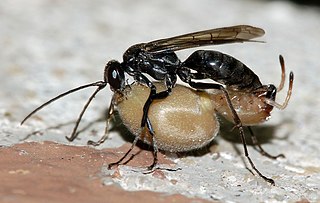
Auplopus is a large genus of spider wasps belonging to the subfamily Pepsinae of the spider wasp family Pompilidae, distributed throughout the world except for Antarctica. Auplopus wasps amputate the legs of their spider prey before transporting it to the nest.

Ceropales is a genus of kleptoparasitic spider wasps from the sub-family Ceropalinae of the family Pompilidae. They are characterised by the taking of the spider prey of other solitary wasps, mainly Pompilidae but members of the Sphecidae that provision with spider prey are sometimes also hosts. In some languages their name translates into English as "cuckoo spider wasp".
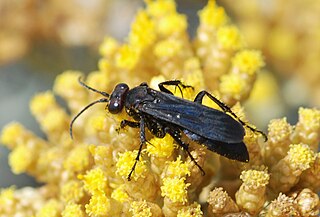
Agenioideus is a genus of spider wasps from the subfamily Pompilinae; the genus occurs in Europe, where 21 species are recorded, eastwards to Japan, in North America, South America, and Australia.

Caliadurgus is a genus of spider wasps of the subfamily Pepsinae. These are medium-sized black spider wasps with some red. They have a catholic habitat choice and their preferred prey are spiders of the families Araneidae and Tetragnathidae. They have a Holarctic and Neotropical distribution.
Priochilus is a genus of neotropical spider wasp in the family Pompilidae.
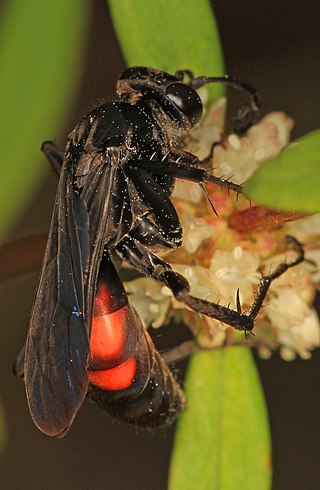
Anoplius americanus is a species of blue-black spider wasp which is widely distributed in the New World.
Ireangelus is a genus of kleptoparasitic spider wasps from the sub-family Ceropalinae of the family Pompilidae. The genus has a pan tropical distribution, being known from Oriental, Neotropical, Australian, eastern Palearctic, and Madagascan Zoogeographic regions being best represented in the Neotropics. Irenangelus is closely related to the more widespread genus Ceropales, the two genera forming a monophyletic subfamily, Ceropalinae within the Pompilidae. This is regarded as the most basal grouping of the Pompilidae but this view is problematic because of the kleptoparasitic life history of the Ceropalines, it is now considered that they Ceropalines and other pompilids evolved from a common ectoparasitoid ancestor.

Tachypompilus analis, the red-tailed spider wasp is a species of spider wasp found in most of tropical and subtropical Asia, north to Japan. These spider wasps often hunt huntsman spiders.

Tachypompilus ferrugineus, the rusty spider wasp, red-tailed spider hunter, or sometimes red-tailed spider wasp is a species of spider wasp from the Americas. It preys mainly on wandering spiders, especially wolf spiders.
The red-tailed spider hunter is a species of spider wasp from western North America.
Paracyphononyx is a genus of spider wasps distributed in the tropics and warmer temperate regions; they differ from other pompilids in that they do not permanently disable the host spider but allow the spider to resume activity after the wasp has laid its egg on the spider while the wasp larva exists as koinobiont ectoparasitoid of the spider.

Poecilopompilus algidus is a species of spider wasp which is widespread in the Americas.
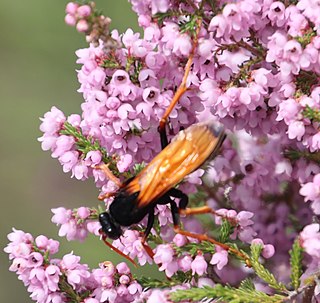
Hemipepsis is a genus of large pepsine spider wasps found throughout the tropics. They are commonly known as tarantula hawks. Hemipepsis wasps are morphologically similar to the related genera Pepsis and Entypus, but distinguishable by the pattern of wing venation. In South Africa 18 plant species from three plant families, the Apocynaceae, Orchidaceae, and Asparagaceae subfamily Scilloideae are pollinated exclusively by Hemipepsis wasps.

Pepsini is a tribe of spider wasps in the family Pompilidae.
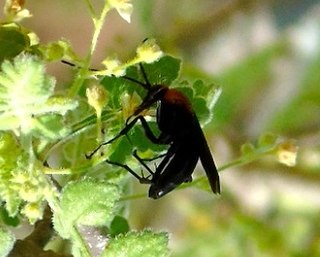
Notocyphus is a genus of spider wasps, belonging to the family Pompilidae. They are the only genus in the monotypic subfamily Notocyphinae. These wasps are found in the Nearctic and the Neotropics.
